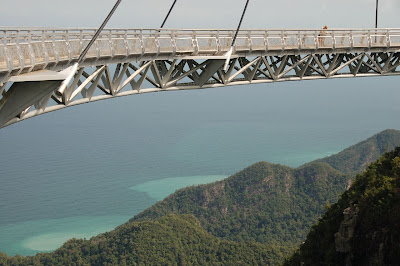Many people will always associate Spain with beautiful beaches and shores, and those are basically the places where most tourists go. However, there are other, very different, sides of this great Iberian Peninsula. This is Spain on the edge...

Our first stop is Malaga and the town Ronda which dates from the Neolithic times. It is a city with over 30,000 inhabitants that was built on two sides of a steep gorge. There are three bridges that connect the two parts of the city. The first is the Puente Romano, or the Roman Bridge, the second one is Puente Viejo or the Old Bridge, and the third one is Puente Nuevo, or the New Bridge which got that name because it was the last one built in 1793.

Puente Nuevo is located about 393 feet from the bottom of a gorge and it is one of the major sights of the city - it's hard to visit Rondo and forget about the bridge and this beautiful sight. Throughout history, many people who were sentenced to death were thrown from this cliff.

Through millenniums, the river Guadalevin carved the canyon El Tajo, which in its deepest part reaches 328 feet. The town itself is high in the mountains at 2,460 feet above the sea level and is located at the top of the canyon. It is unlikely that its inhabitants suffer from vertigo...

However, Ronda isn't the only place in Spain where people are living on the edge of an abyss. If we move near the French border, you'll see the Catalan city of Castellfollit de la Rocha.

Many, many years ago, there was a volcanic eruption. Two streams of lava overlapped and made a ridge around 170 feet high. Is there a more secure place to live then on the places which are so high on the ridge that you can see everything for miles around?

City is situated in the province of Girona. The town itself is extremely small - it was built on an area that covers less than one square mile.

Now we will turn around and move away from the populated areas. Spaniards are not afraid of heights, and by now we know that. But still, they probably shudder when see El Caminito del Rey - The King's little pathway, which is just like Ronda, located in Malaga.

A power station was built near the waterfall at the beginning of the 20th century. It caused problems in delivering building materials. This "pathway" was originally created as a platform for viewing the channel and the immediate vicinity of the plant. After four years, in 1905, the power plant was finally built and put into operation, and this platform became a real world attraction because it was quite a feat of engineering in that time.

However, only a few very bold and daring people attempt to cross this platform today.

Sometimes it makes sense to establish a settlement at the top of the gorge, but dig into it is another thing. This is Setenil de las Bodegas in Andalucia, which represents a modern village that dates back from the fifteenth century, although there is evidence that people lived here thousand years ago.

People come to visit this village because something like this cannot be seen everywhere else. It looks like a scene from a science fiction novel. People dug places in the foothills of the mountain and on one side of the gorge and they lived there.

The village is also on the river Trejo and is it has more than 3,000 inhabitants.

To get a better view of the size (and height) of Spain, our next stop is Cuenca. It is a mountain town in the Cuenca province. Province itself is quite big - almost like Slovenia.


During Roman times there was no settlement here. Arabs, who invaded this territory in the eighth century, saw the strategic importance of this place and built a fort which they called Cuenca. Cuenca later became a prosperous city and a center of local agriculture and textile industry.

There are many beautiful locations in the city and its surroundings, but our focus will be on the famous hanging houses - Las Casas Colgadas which date from the fifteenth century.

Today, this is a restaurant and museum of abstract art.

City Sorbas in Almeria province also has similar "hanging houses" - they also stand on the edge of an abyss.


The Historic Centre of Sorbas is located on Cape Amesetado, and the city witnessed all the cultures that have settled on the peninsula over the centuries.

The last city on this tour is in the south of the country and it is called Arcos de la Frontera. It is located in Cadiz. The reef, on which the city was built, is not the product of volcanic activity; it was formed from limestone and is located on the river Guadalete.

Spaniards and Moors have fought very long to gain control over the land. The town was always the border between the two conflicted sides and that is how it got its name.

It was an independent Moors Principality during the eleventh century. However, in 1252, King Alfonso the Wise conquered it. He was responsible for the exodus of Moors from Spain and he built a cathedral on a top of the hill. The cathedral is famous because of its 10 bells.

As we can see, Spain is not just sand and sea. It is land is rich in geographic diversity and we hope that we managed to show that in full color.
images source: kuriositas.com




















































































